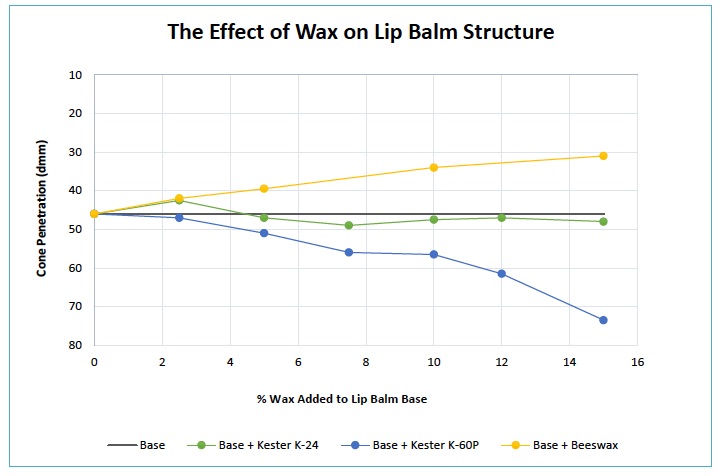To modify the texture of a formulation, a greater comprehension of wax chemistry is indispensable. Wax has a general definition, but does not contain specificity on the variables of chemical compounds found within this classification. Differentiating wax chemistry is critical in creating textural changes in formulation. Beeswax is one of the most complex natural waxes used today. It has deep roots in the cosmetic industry, and has been the go-to wax for millennia. This amazing compound allows for an incredible range of formulation textures. In lip balms alone, beeswax offers the possibility of creating firm-structured sticks, to soft, glossy squeezable balms.
Different Waxes Provide Different Types of Structure
While all waxes have certain common parameters, its ordinary definition is based largely on physical properties that do not take into account the chemical complexities of each wax. This chemical complexity is why waxes do not always behave similarly in different systems. For example, not all waxes provide increased structure, even as they increase in proportion to oils in a given formula. A key detail here is that waxes are not interchangeable. At Koster Keunen, we continue to examine these complexities, from the structural features of waxes to the ways they behave in multiple formulations. In one experiment, we added three different waxes (Beeswax, Kester K-24 and Kester K-60P) to a stable lip balm base in increasing percentages and measured the change in hardness of the balm for each type of wax.

The results showed very clearly that all waxes are not the same. First, the balm’s hardness increased as the amount of beeswax increased. Kester K-24 had no effect on hardness; however, it changed the overall texture of the balm. At the other extreme, the Kester K-60P actually softened the balm and increased creaminess as the percentage in the formula increased.
The Versatility of Wax
Working with beeswax for over 165 years has given the team at Koster Keunen a deeper knowledge of this chemistry. We have discovered an ever-increasing range of applications for beeswax. Adding beeswax to lip balm may seem simple, but in formulation, beeswax provides multifunctionality. It acts as a structurant, texturizing agent, and a plasticizer; all important for stick integrity, smooth texture, flexibility and even color distribution. The unique chemistry of beeswax provides plasticizing properties that help prevent crystallization, “sweating,” and bloom in stick formulations. Beeswax thickens and structures oils by forming stable gel networks, with gel viscosity and hardness proportional to the percent of beeswax in the formulation.
Choosing the Right Texture for Your Product
The extraordinary versatility of beeswax allows for use in a wide range of products. When formulating balms, the right sensory attributes make all the difference to product acceptance and preference. Koster Keunen’s beeswax expertise is second to none in formulation and innovation. You can read more about our research into transforming textures with beeswax or contact us for an opportunity to test prototypes during a virtual demonstration of the unique properties of wax.
About Koster Keunen
Koster Keunen has been working with wax since 1852 and has used our extensive experience and knowledge base to continuously develop new chemistries. Whether you are developing a new product, or need help with a reformulation or replacement, contact us to learn more about how we source, refine or develop waxes so you can create the perfect formula.

